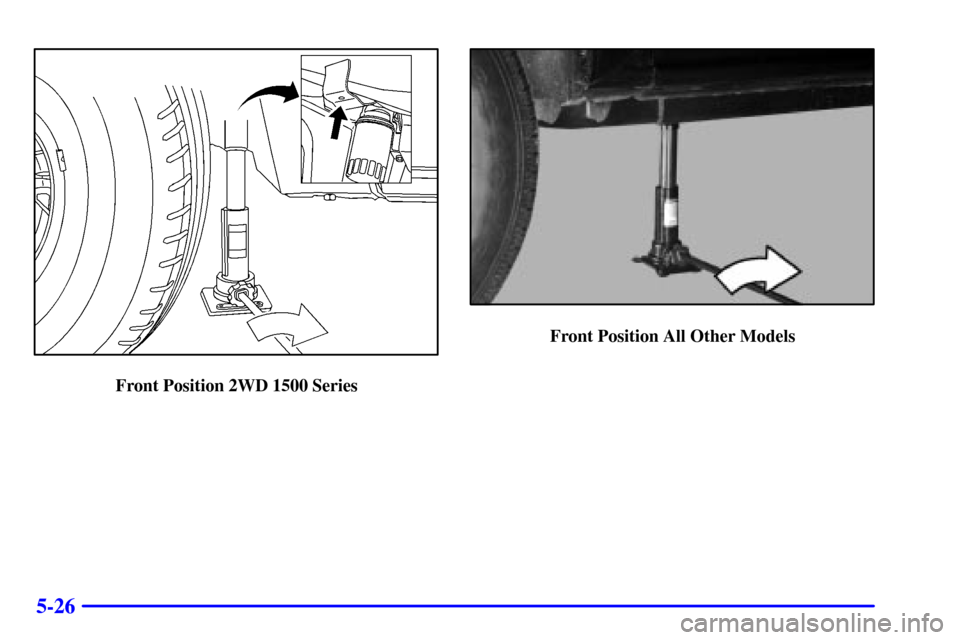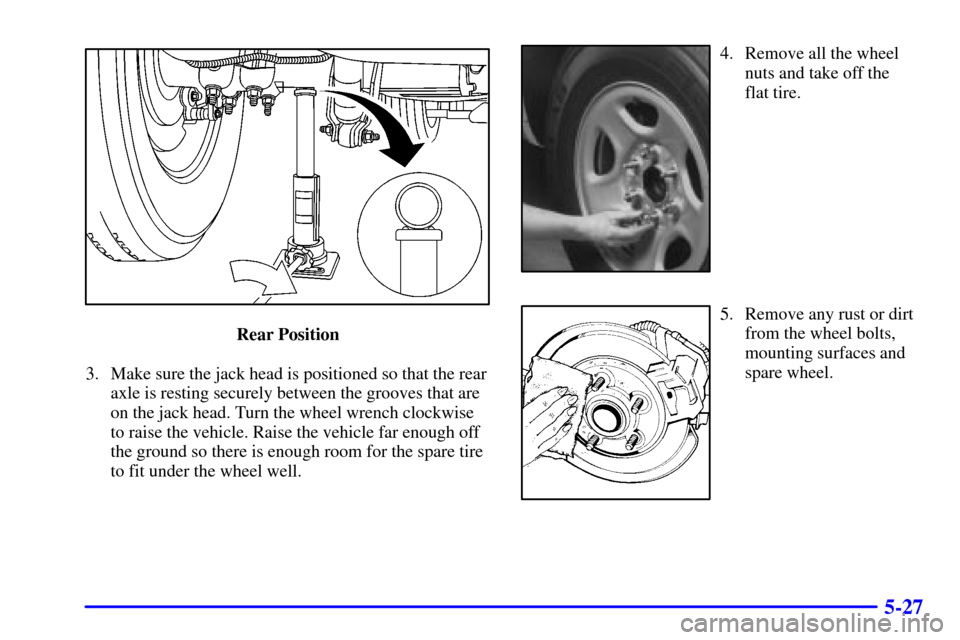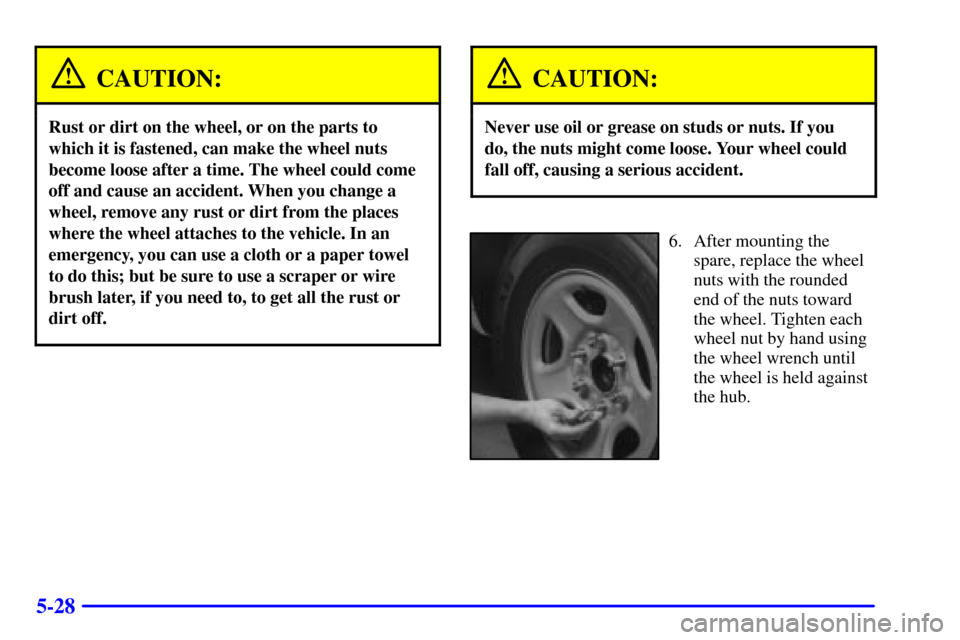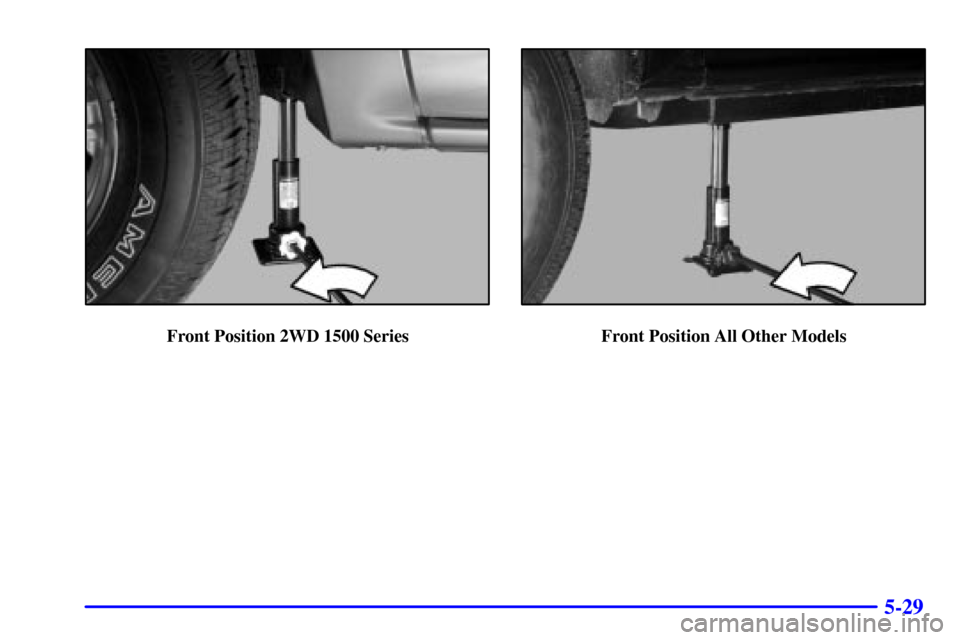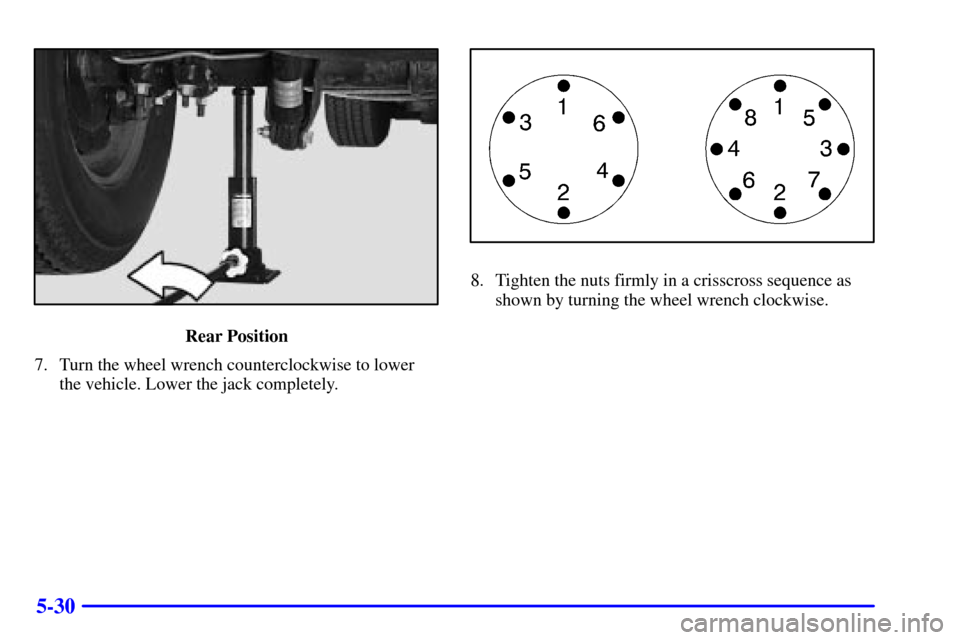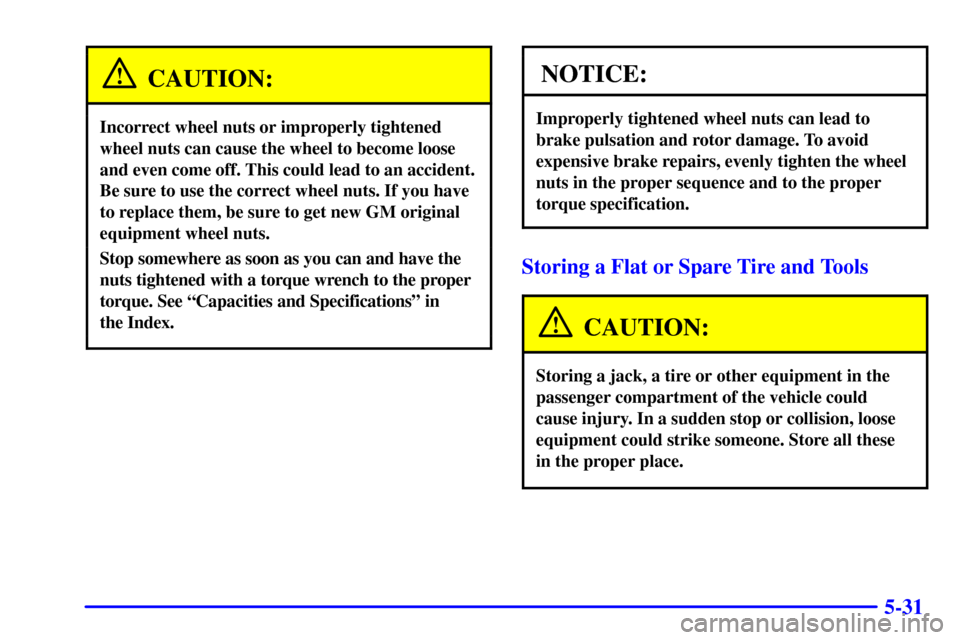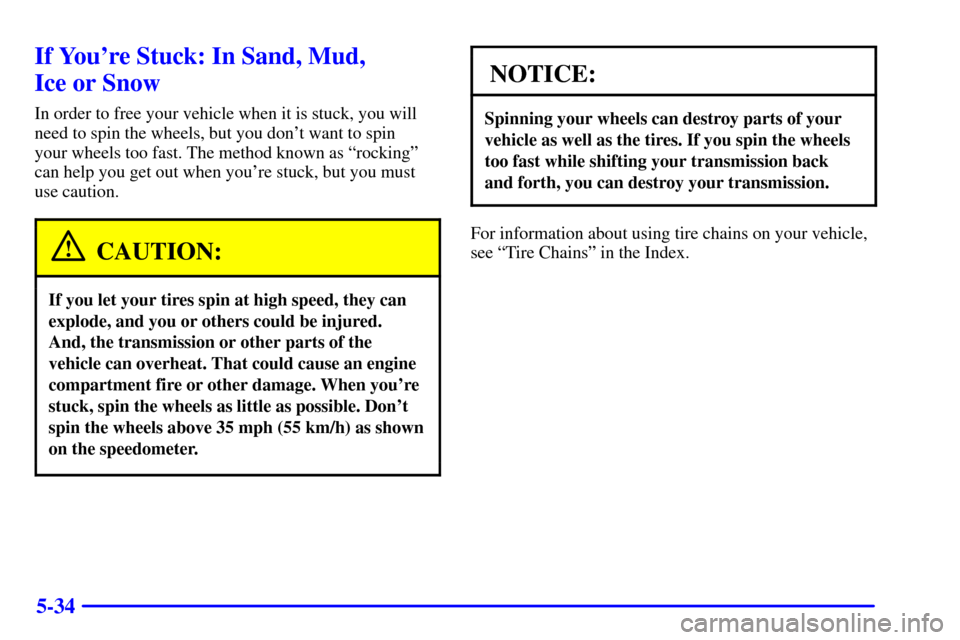CHEVROLET SILVERADO 2001 1.G Owners Manual
SILVERADO 2001 1.G
CHEVROLET
CHEVROLET
https://www.carmanualsonline.info/img/24/8272/w960_8272-0.png
CHEVROLET SILVERADO 2001 1.G Owners Manual
Trending: radiator, automatic transmission, service indicator, coolant temperature, transmission oil, jump start, radio
Page 331 of 468
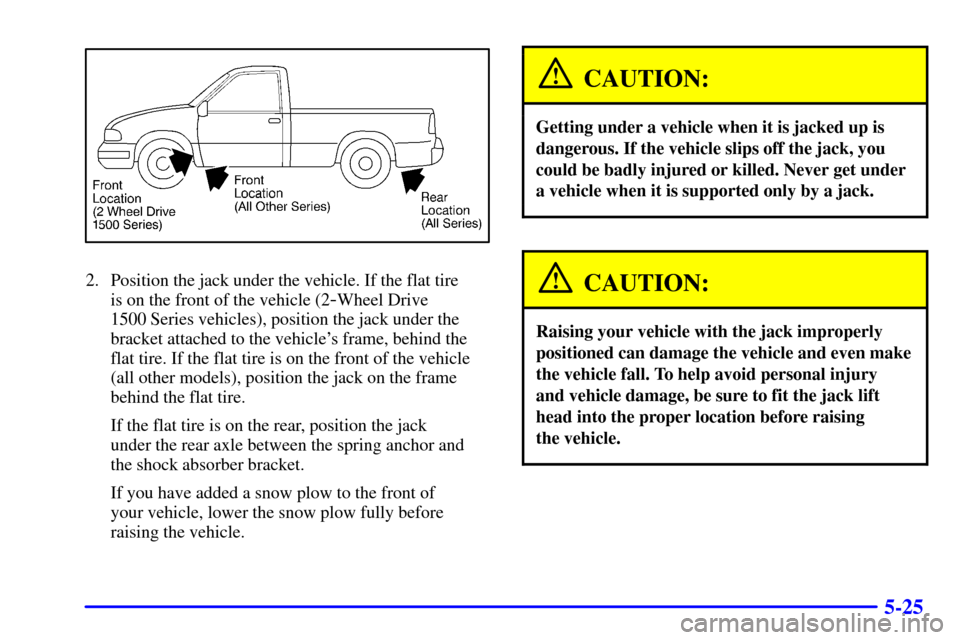
5-25
2. Position the jack under the vehicle. If the flat tire
is on the front of the vehicle (2
-Wheel Drive
1500 Series vehicles), position the jack under the
bracket attached to the vehicle's frame, behind the
flat tire. If the flat tire is on the front of the vehicle
(all other models), position the jack on the frame
behind the flat tire.
If the flat tire is on the rear, position the jack
under the rear axle between the spring anchor and
the shock absorber bracket.
If you have added a snow plow to the front of
your vehicle, lower the snow plow fully before
raising the vehicle.
CAUTION:
Getting under a vehicle when it is jacked up is
dangerous. If the vehicle slips off the jack, you
could be badly injured or killed. Never get under
a vehicle when it is supported only by a jack.
CAUTION:
Raising your vehicle with the jack improperly
positioned can damage the vehicle and even make
the vehicle fall. To help avoid personal injury
and vehicle damage, be sure to fit the jack lift
head into the proper location before raising
the vehicle.
Page 332 of 468
5-26
Front Position 2WD 1500 Series
Front Position All Other Models
Page 333 of 468
5-27
Rear Position
3. Make sure the jack head is positioned so that the rear
axle is resting securely between the grooves that are
on the jack head. Turn the wheel wrench clockwise
to raise the vehicle. Raise the vehicle far enough off
the ground so there is enough room for the spare tire
to fit under the wheel well.
4. Remove all the wheel
nuts and take off the
flat tire.
5. Remove any rust or dirt
from the wheel bolts,
mounting surfaces and
spare wheel.
Page 334 of 468
5-28
CAUTION:
Rust or dirt on the wheel, or on the parts to
which it is fastened, can make the wheel nuts
become loose after a time. The wheel could come
off and cause an accident. When you change a
wheel, remove any rust or dirt from the places
where the wheel attaches to the vehicle. In an
emergency, you can use a cloth or a paper towel
to do this; but be sure to use a scraper or wire
brush later, if you need to, to get all the rust or
dirt off.
CAUTION:
Never use oil or grease on studs or nuts. If you
do, the nuts might come loose. Your wheel could
fall off, causing a serious accident.
6. After mounting the
spare, replace the wheel
nuts with the rounded
end of the nuts toward
the wheel. Tighten each
wheel nut by hand using
the wheel wrench until
the wheel is held against
the hub.
Page 335 of 468
5-29
Front Position 2WD 1500 SeriesFront Position All Other Models
Page 336 of 468
5-30
Rear Position
7. Turn the wheel wrench counterclockwise to lower
the vehicle. Lower the jack completely.
8. Tighten the nuts firmly in a crisscross sequence as
shown by turning the wheel wrench clockwise.
Page 337 of 468
5-31
CAUTION:
Incorrect wheel nuts or improperly tightened
wheel nuts can cause the wheel to become loose
and even come off. This could lead to an accident.
Be sure to use the correct wheel nuts. If you have
to replace them, be sure to get new GM original
equipment wheel nuts.
Stop somewhere as soon as you can and have the
nuts tightened with a torque wrench to the proper
torque. See ªCapacities and Specificationsº in
the Index.
NOTICE:
Improperly tightened wheel nuts can lead to
brake pulsation and rotor damage. To avoid
expensive brake repairs, evenly tighten the wheel
nuts in the proper sequence and to the proper
torque specification.
Storing a Flat or Spare Tire and Tools
CAUTION:
Storing a jack, a tire or other equipment in the
passenger compartment of the vehicle could
cause injury. In a sudden stop or collision, loose
equipment could strike someone. Store all these
in the proper place.
Page 338 of 468

5-32
Return the bottle jack, wheel blocks, wheel wrench and
jack extensions to their location behind the passenger's
seat. Secure the items in the vehicle as shown.
A. Wing Nut
B. Wheel Blocks
C. Wheel Wrench and
Extensions Retainer
D. GlovesE. Wheel Wrench
and Extensions
F. Storage Bag
G. Bottle Jack Holder
H. Bottle Jack
I. Wheel Block
RetainerStore the tire under the rear of the vehicle in the spare
tire carrier. To store the tire, do the following:
1. Put the tire on the ground at the rear of the
vehicle with the valve stem pointed downward
and to the rear.
2. Tilt the retainer downward and through the wheel
opening. Make sure that the retainer is fully seated
across the underside of the wheel.
3. Attach the wheel wrench and extensions together.
Insert the hoist end through the hole in the rear
bumper and into the hoist shaft.
4. Raise the tire part of the way upward. When the tire
is almost in the stored position, adjust the tire so that
the valve stem is toward the rear of the vehicle.
Page 339 of 468
5-33
A. Hoist Assembly
B. Wheel Wrench
C. Extensions
D. Hoist ShaftE. Valve Stem,
Pointed Down
F. Flat or Spare Tire
G. Retainer
H. Hoist Cable
5. Raise the tire fully against the underside of the
vehicle. Continue turning the wheel wrench until the
tire is secure and the cable is tight. The spare tire
hoist cannot be overtightened.
6. Make sure the tire is stored securely. Push, pull, and
then try to rotate or turn the tire. If the tire moves,
use the wheel wrench/hoist shaft to tighten the cable.
Replace the jack, tools and spare tire lock.
Page 340 of 468
5-34
If You're Stuck: In Sand, Mud,
Ice or Snow
In order to free your vehicle when it is stuck, you will
need to spin the wheels, but you don't want to spin
your wheels too fast. The method known as ªrockingº
can help you get out when you're stuck, but you must
use caution.
CAUTION:
If you let your tires spin at high speed, they can
explode, and you or others could be injured.
And, the transmission or other parts of the
vehicle can overheat. That could cause an engine
compartment fire or other damage. When you're
stuck, spin the wheels as little as possible. Don't
spin the wheels above 35 mph (55 km/h) as shown
on the speedometer.
NOTICE:
Spinning your wheels can destroy parts of your
vehicle as well as the tires. If you spin the wheels
too fast while shifting your transmission back
and forth, you can destroy your transmission.
For information about using tire chains on your vehicle,
see ªTire Chainsº in the Index.
Trending: engine coolant, fuel pump, length, ESP inoperative, gas type, jacking, radio antenna

